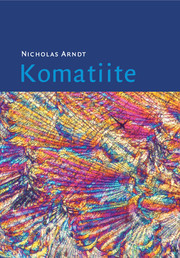Book contents
- Frontmatter
- Contents
- Preface
- Part I Background information – description of the field characteristics, mineralogy and geochemistry of komatiites
- Part II Interpretation – the manner of emplacement, the origin and the tectonic setting of komatiites
- 8 Physical properties of komatiites
- 9 Physical volcanology (by S. J. Barnes and C. M. Lesher)
- 10 Komatiite-associated Ni–Cu–PGE deposits (by C. M. Lesher and S. J. Barnes)
- 11 The hydrous komatiite hypothesis
- 12 Compositions and eruption temperatures of komatiitic liquids
- 13 Petrogenesis of komatiite
- 14 Geodynamic setting
- References
- General index
- Localities
- Plate section
14 - Geodynamic setting
from Part II - Interpretation – the manner of emplacement, the origin and the tectonic setting of komatiites
Published online by Cambridge University Press: 27 August 2009
- Frontmatter
- Contents
- Preface
- Part I Background information – description of the field characteristics, mineralogy and geochemistry of komatiites
- Part II Interpretation – the manner of emplacement, the origin and the tectonic setting of komatiites
- 8 Physical properties of komatiites
- 9 Physical volcanology (by S. J. Barnes and C. M. Lesher)
- 10 Komatiite-associated Ni–Cu–PGE deposits (by C. M. Lesher and S. J. Barnes)
- 11 The hydrous komatiite hypothesis
- 12 Compositions and eruption temperatures of komatiitic liquids
- 13 Petrogenesis of komatiite
- 14 Geodynamic setting
- References
- General index
- Localities
- Plate section
Summary
Introduction
In what type of tectonic environment did komatiite erupt? For all komatiites, but particularly those of Archean age, the setting can best be estimated from the nature of associated rocks, and the broader tectonic setting must be inferred using general information about the structure of the region and the overall geological context. Given our poor knowledge of the geodynamic regime(s) that existed in the Archean, any attempt to infer the exact setting is subject to considerable uncertainty. In several regions, komatiite appears to have erupted onto continental crust that was covered by shallow seas, a setting that is rarely encountered in the modern tectonic environment. Any investigation of the eruptive setting must take into account the peculiarities of the Archean environment, including the hotter mantle (Bickle, 1978; Richter, 1988), thicker oceanic crust (Sleep and Windley, 1982; Vlaar, 1986) and hotter continental crust (because of enhanced radioactive heating) (Mareschal and Jaupart, 2006).
Many papers that treat the tectonic setting of Archean terrains dwell on the post-magmatic history and particularly the structural evolution of granite-greenstone belts (e.g. Sylvester et al. (1997), Wyman et al. (2002), Van Kranendonk et al. (2004), Benn et al. (2006)). Papers such as these discuss the accretion of fragments of oceanic crust and island arcs, and go in detail into the post-volcanic history of deformation, metamorphism and granite intrusion. While important in any general discussion of Archean tectonics, this history follows, and is largely independent from, the eruption of komatiite.
- Type
- Chapter
- Information
- Komatiite , pp. 390 - 414Publisher: Cambridge University PressPrint publication year: 2008



